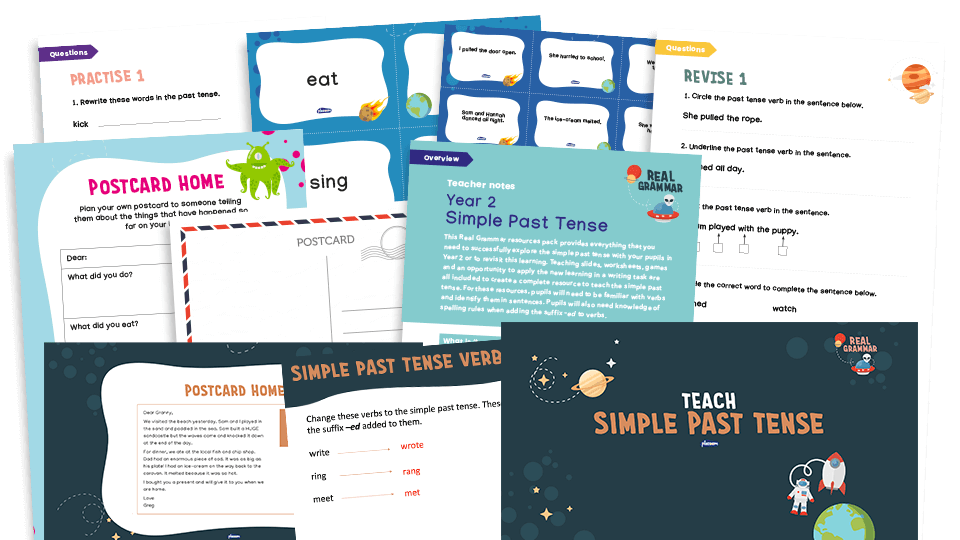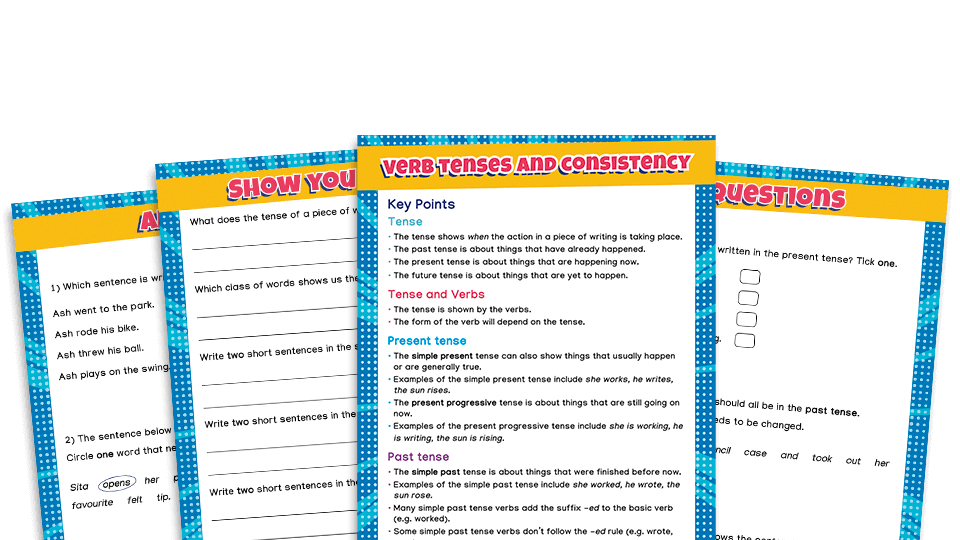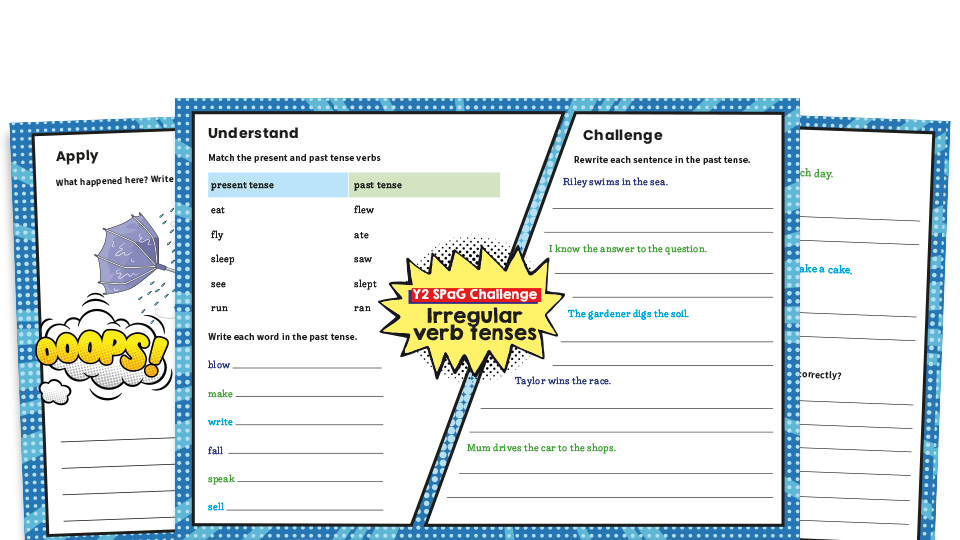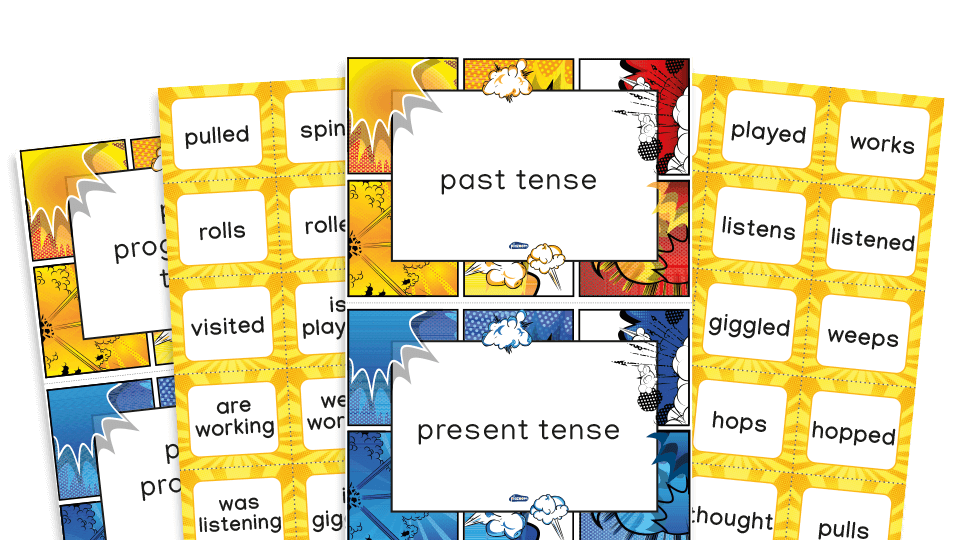They say you shouldn’t dwell on the past. But when it comes to teaching tenses at KS1, the past is something that might need a little more attention. Can you confidently teach the difference between the various forms and where pupils should use each one?
Below are some ideas for making sure your understanding of this topic is all present and correct. We've also included some examples of how to use past tenses – not necessarily because you need them, of course, but it is nice to have a reminder every now and again!
Simple past tense explanation
The tense of any piece of writing tells you when the action happens. Things that happened, had happened or were happening before the present moment count as the past.
Along with the person (first, second and third), it is the tense that determines which form of the verb we should use in any sentence.
When trying to help young writers get the hang of this, the simple inclusion of an obvious time frame, such as the words yesterday or already, is often all it takes to clarify matters. For example:
- I washed up yesterday.
- I was playing football last week.
You can also help to secure this understanding by using our past tense SPaG challenge mat.

You can also keep these ideas at the forefront of students' minds by displaying our interactive SPaG posters.

Genre and tense
The dominant tense of a text often depends on the genre. However, it usually helps to remind pupils about this on a regular basis.
Stories are almost always in the past. Diary entries and recounts of events are, by definition, set in the past.
That doesn’t mean that you have to write absolutely every verb in that piece in the past tense – more on that in a moment. However, it is often useful to include a reference to past tense verbs in any checklist or set of success criteria.
This Year 2 pack provides everything you need to teach or revisit the simple past tense. Pupils will use the simple past tense to plan and write a postcard, putting their grammar learning into context.

A word on using tense with consistency
The stated requirement at KS1 is that pupils are able to use the past and present tense mostly correctly and consistently.
However, it is perfectly possible to have present tense verbs in texts that are primarily set in the past. For example, it would be correct for a pupil to write:
- We went on a trip to Walmouth yesterday. Walmouth is a castle that was built hundreds of years ago.
The same is often true in dialogue:
- “I am so grateful,” said the old man.
Simple past tense
This is possibly the most familiar of the past tenses. It’s the one that often involves adding the suffix -ed to the end of the verb.
The main thing to watch here is the various spelling rules concerning verbs that end in y (marry – married) and those where you need to double the consonant to preserve the short vowel sound.
After all, there is a big difference between the gardener hoped for rain and the gardener hopped for rain.
Keep your class on top of their game by using our KS1 verb tenses grammar recap worksheets.

Irregular verb use in past tense
One of the most charming aspects of children’s language development is when they have clearly picked up a rule, such as the addition of -ed for the simple past tense, but haven’t yet learned the exceptions: "She telled me to do it,” for instance.
Sadly, there is little option but to just expose them to irregular verbs as often as possible – our SPaG challenge mat can help you there, or try our irregular verbs bingo game for Year 2.

It is also important to kindly correct them when they do make a spoken mistake, including those thrown up by the quirks of local dialects.
Where I live in Suffolk, for example, they long ago noticed a pattern in the way that verbs ending -ow took the irregular past tense ending of -ew (know, knew; throw, threw) but overzealously applied it to show too (I shew her how to do it).
Understanding the progressive
Introduced in Year 2, we use the progressive tense to show when an action or state is continuing to happen, and can be either present or past.
The verbs in this verb form end with the suffix -ing. We use the past progressive tense (sometimes called the past continuous tense) to show that something (an action or event) continued for some time or that something was not finished before something else happened.
It is formed using the verbs was / were and the verb ending in the suffix -ing (present participle). For example: She was walking.
This ‘Make a Match’ game helps Year 2 pupils practise identifying verbs in the past, present and progressive tense. They match the words using 44 word cards and four heading cards, either as a class or in small groups.

What about the perfect?
Although we don't introduce it to pupils until Year 3 (present perfect) and Year 5 (past perfect), it's helpful for teachers in KS1 to be aware of the perfect tense.
The present perfect tense is for actions that started before now but are still true or still ongoing:
- He has finished his work.
- She has taught at this school for ten years.
You’ll notice that we form it by adding the present tense of the verb to have plus the simple past tense of the action in question.
The past perfect is for actions that had been undertaken and completed in the past. For example:
- They had baked all their contributions for the cake stall
- Thankfully, she had written all her reports.
This time, we use the past tense of the verb to have along with the past tense of the main verb.
Remember, there are other forms of past and present tenses, not to mention the future tense, but those are not expected to be taught until KS2. For now, we hope this has taken the tension out of tenses at KS1.
Sue Drury qualified as a primary teacher in 1999. Teaching pupils from Year 1 to Year 8, she has held a variety of positions including maths and English subject leader, year leader, and assistant headteacher. Sue has mentored students and NQTs, offering guidance and advice using her years of experience. She created many of Plazoom's literacy resources.